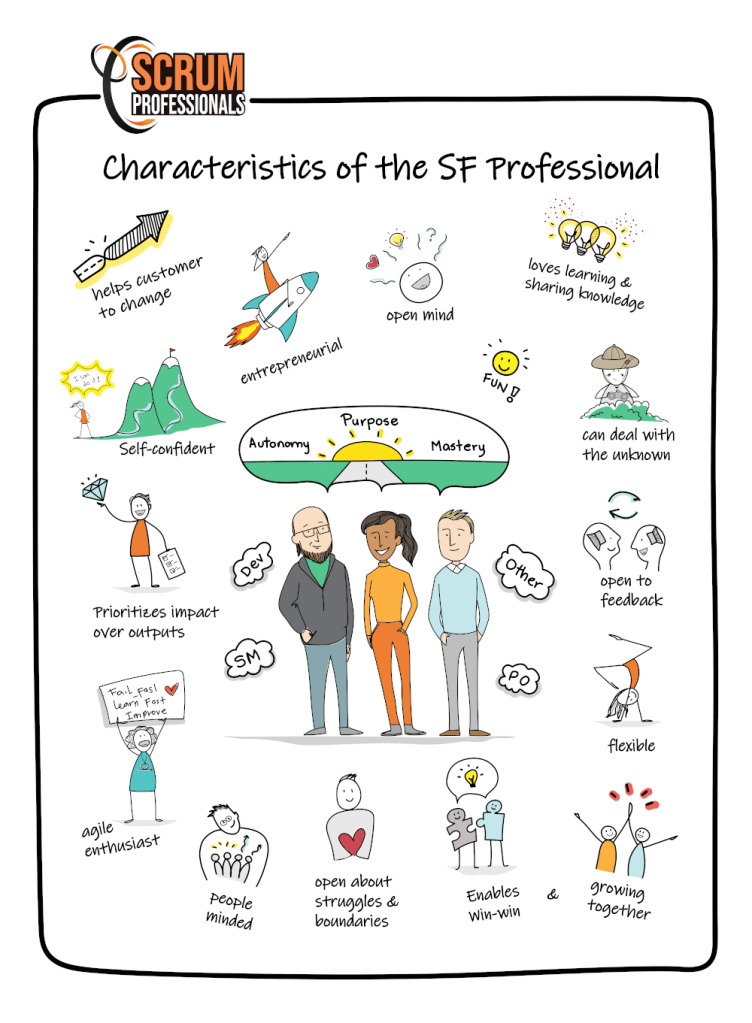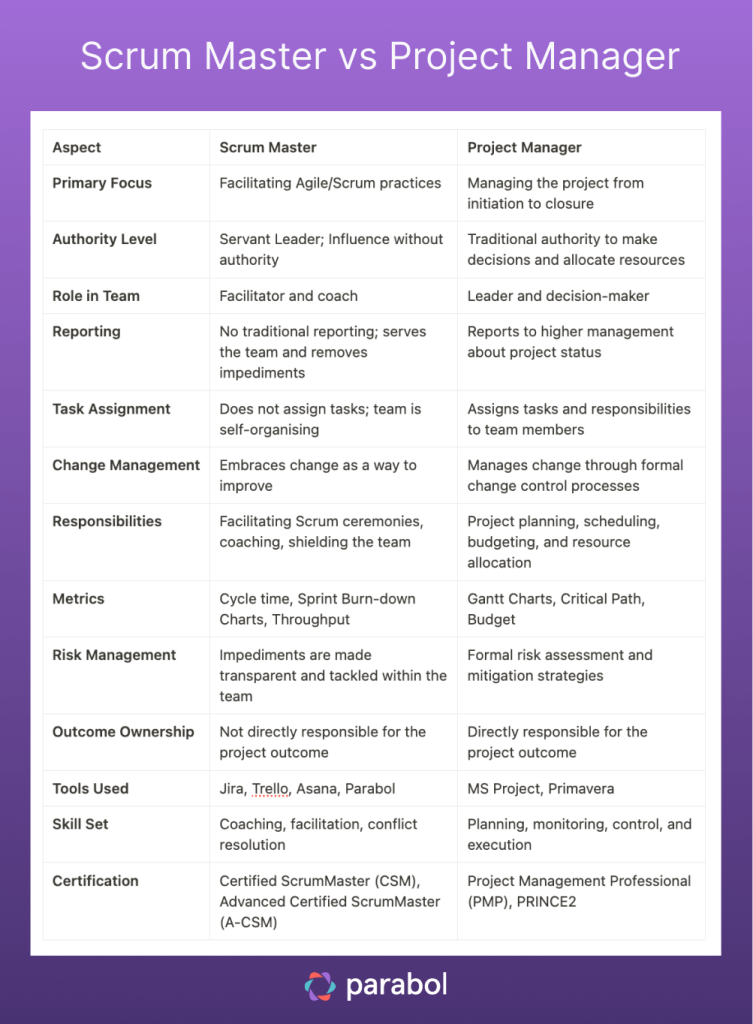Steal This Scrum Master Job Description Template (Reviewed by Experts)

Too many Scrum Master job descriptions read like Agile parodies. “Wanted: Scrum Masters to ‘hold the team accountable’ and ‘manage projects within time and budget.'” 😬
Such job ads turn Scrum satire into tragedy. Well-intentioned Scrum Masters join organizations that talk Agile but walk traditional project management. Companies that want an agile transformation often alienate potential hires with job descriptions that misrepresent or completely misunderstand the role.
You can avoid this trap by stealing our Scrum Master job description template, peer-reviewed by several Agile professionals with decades of combined experience.
Scrum Master job description template
[Company name] is looking for a Scrum Master who will help [brief description of the type of team they’ll be joining and the kind of product or service they’ll work on].
We believe being a good Scrum Master is part science, part art. Guiding teams in their Scrum practice to elevate their performance doesn’t happen by passing an exam and learning rules. We emphasize a balance of soft skills and a deep understanding of Agile methodologies as requirements, while hard measurables like certifications are desirable and optional extras.
Scrum Master requirements
- A passion for Agility. You embody agile values and principles.
- You know Scrum inside out but also deeply understand other Agile principles, values, and practices. – the Scrum Guide doesn’t hold the answer to every challenge for every team.
- You’re a servant leader who puts the needs of the team first. You care deeply about their well-being and performance and are comfortable coaching and mentoring team members.
- You’re a daring, free thinker, not afraid to seek and experiment with creative solutions to challenges.
- [OPTIONAL, for enterprise environments: Experience scaling Scrum, preferably with frameworks like SAFe or LeSS.]
Scrum Master qualities & key skills
- Facilitation: You have experience effectively facilitating team discussions and Scrum events so they lead to valuable outcomes.
- Adaptability: You quickly adapt to changing situations and requirements and encourage the team to do the same.
- Partnering: You know how to build partnerships with the Product Owner and other organizational stakeholders to remove roadblocks.
- Transparency: You always promote an open and transparent communication environment.
- Integrity: People can trust you and feel they can do so naturally and quickly.
- Continuous improvement: You’re a champion for practicing continuous improvement and continuously help the team reduce waste and improve their performance.
- Conflict resolution: You’re skilled at helping others resolve conflicts to ensure a positive and productive working environment.
- [OPTIONAL: Remove or adjust according to your requirements of the role.] Technical proficiency: Basic understanding of product development and essential technologies related to our product and industry.
Scrum Master desirables
- PSM I, II, or III certifications are helpful indicators of your skills and experience but not leading factors in our assessment.
- Ideally, {insert desired number} years of experience as a Scrum Master for a {insert industry} team.
- [OPTIONAL: Adjust according to your internal tool stack.] Familiarity with Agile tools like Jira, Parabol, Trello, or Asana.
- [OPTIONAL: Adjust according to your (technical) requirements for the role.] Previous experience as a developer or in another role on agile teams is a plus.
- [OPTIONAL: Depends on your company’s work environment.] Experience in remote facilitation and leading distributed teams.
- Excellent communication and stakeholder management skills.
Job description template peer reviewed by:
- Erwin van Maren, Entrepreneur and Agile Consultant at De Kompanen
- Petula Guimaraes, Agile and Leadership Coach
- Erik de Bos, Scrum and Flow Master
Things to know before you publish your Scrum Master job offer…
We’ve vetted the template so you can feel confident posting it without reading the rest of this article. But the more you understand our template and the Scrum Master role, the better you can tailor your job posting to find your ideal candidate.
In the following sections, we go into some nuances of the Scrum Master position so you can optimize your recruitment process and strategy.
1. Know how to use the template
Like Agile itself, this template is adaptable, providing a foundation you can build upon depending on your unique situation. Are you a startup or an enterprise? Are you looking for a Scrum Master for a newly-formed team or a veteran group? These factors will influence what your ideal candidate looks like.
Feel free to add, remove, or shift elements between the ‘Requirements,’ ‘Skills,’ and ‘Desirables’ sections to match your needs.
Tips for tailoring the template:
- Introduce your company. A brief company description sets the tone and attracts those who align with your mission and culture. But skip the corporate buzzwords – they won’t fool anyone, least of all an experienced Scrum Master.
- Provide application instructions. You want quality over quantity. Explain to candidates how to apply and ask for specific information in addition to their resume, like how they’ve resolved a team conflict or facilitated a particularly challenging Sprint.
- Talk benefits and flexibility. Salary is a crucial consideration for top talent – but not the only one. Many Scrum Masters value benefits like ongoing education, conference attendance, and working remotely. Make sure to outline and give examples of what makes working at your company profitable, enjoyable, and enriching.
- Be transparent about your Agile journey. If your organization is new to Agile or in the middle of a transformation, say so. Experienced Scrum Masters often relish the challenge of driving agile transformations and may be more inclined to join.
By tailoring your job description in these ways, you set clear expectations and make the position more appealing, attracting applicants who are a good fit for both the role and your company.
2. Understand the Scrum Master role
You don’t need a Scrum Master certification yourself to feel confident hiring one. But a deeper understanding of the role helps you tailor your job posting, connect with the right candidates, and weed out the less qualified ones.
This excellent graphic maps out the general contours of a great Scrum Master!

The top 7 accountabilities of a Scrum Master
These are a Scrum Master’s seven primary responsibilities in serving other members of their team:
- Facilitation: The Scrum Guide emphasizes that the Scrum Master is a servant-leader for the Scrum Team, and one of the ways they serve is by facilitating Scrum events as requested or needed.
- Coaching: The Scrum Master helps the team – and often the broader organization – understand Scrum theory, practices, rules, and values.
- Focus enhancement: The Scrum Master creates an environment that minimizes disruptions and teaches the team how to handle distractions when they arise.
- Impediment awareness: The Scrum Master empowers the team to recognize impediments and equips them with tools to address these challenges collaboratively.
- Product Owner support: The Scrum Master aids the Product Owner in facilitating communication with stakeholders and ensures the visibility of the backlog and product goal.
- Continuous improvement: The Scrum Master guides and motivates the team to adopt Agile continuous improvement practices, like holding regular retrospectives.
- Conflict resolution: Resolving conflicts in and outside the team to maintain a positive and productive environment. In such cases, the Scrum Master takes a mediating or facilitating role, not one of a judge.
What does a Scrum Master do all day?
Let’s briefly experience a hypothetical day in the life of a Scrum Master to get a better appreciation for the role.
Imagine the Scrum Master starting their day not with a to-do list but a “to-serve” list. List in hand, they join a virtual call or walk into a meeting room fully prepared to focus and facilitate.
The Daily Standup meeting kicks off promptly, a rhythmic event that brings the developers together to inspect progress toward the Sprint Goal. The Scrum Master ensures everyone is heard and that the team zeros in on what matters: looking ahead 24 hours and tackling impediments.
A developer mentions a pesky roadblock that’s slowing them down. The Scrum Master responds with a question: “Why is that an impediment?” This prompt encourages the developer to analyze the problem and find a solution.
But the day is far from over.
The Scrum Master might spend the afternoon coaching a junior team member on Agile principles or supporting the Product Owner in negotiations with a stakeholder whose demands threaten to derail the current Sprint. And then there’s the one-on-one with the Product Owner to discuss ways to better refine the product backlog.
As the day winds down, the Scrum Master reflects on their primary role: not to micromanage but to serve, remove obstacles, and help the team self-organize and innovate. It’s a role that demands versatility, empathy, and an unwavering commitment to Agile values.
Tomorrow will be another day of service, and a real Scrum Master wouldn’t have it any other way.
Role comparison: Scrum Master vs. project manager
Many Scrum job descriptions sound more like project manager descriptions. But a project manager often takes a more traditional, control-oriented approach. The Scrum Master, on the other hand, assumes a servant-leader role, focusing on empowering the team rather than directing it.
Think of the project manager as the planner with a Gantt chart and the Scrum Master as the coach on the sidelines cheering the team on.
⚠️ The table below outlines common distinctions between Scrum Masters and Project Managers. These descriptions tend to compare the extreme differences between the two roles. The actual dynamics can vary based on the organization, the nature of the project, and other contextual factors.

3. Benchmark your Scrum Master salary
Salaries for Scrum Masters vary depending on several factors, including experience level, geographic location, industry, and education.
According to Age of Product’s 2023 survey, the average salary for a Scrum Master is $80,995, while Glassdoor puts it at $106,047 (at the time of writing).*
You can use both Glassdoor and Salary.com for real-time Scrum Master salary benchmark data.
* Several factors might explain the difference between these two numbers. Glassdoor is more US-centric, where salaries tend to be higher than in Europe, where Age of Product originates. Age of Product also specializes in its focus on Agile and Scrum roles. Their survey could target a subset of Scrum Masters, perhaps with a different balance of industries, geographies, or experience levels compared to the broader data set collected by Glassdoor.
4. Check for Scrum Master job description red flags 🚩
Certain words or requirements in a Scrum Master job description can indicate a misunderstanding of the role or a company culture that’s not truly agile. When you come across any of the following red flags, proceed with caution.
1. Micromanagement language
Terms like “command and control,” “manage the team,” or “reporting to upper management” are telltale signs that the company may not fully understand the servant-leader nature of a Scrum Master. Scrum Masters facilitate and coach; they don’t manage in the traditional sense.
2. Fixed roles and responsibilities
When the job description specifies that the Scrum Master will only be doing X, Y, and Z tasks, it’s a red flag. Agility is about adaptability; the Scrum Master’s role can evolve depending on the team’s needs.
3. Only focus on Scrum events
If the job description only talks about facilitating Daily Standups, Sprint Planning, and Retrospectives, it’s missing the broader scope of the Scrum Master role, such as coaching and impediment removal.
4. Lack of emphasis on coaching and mentoring
A Scrum Master is not an administrator but a coach and mentor to the team. The absence of such terminology in the job description is a negative indicator.
5. Waterfall or hybrid models
Terms like “Phase-Gate,” “Water-Scrum-Fall,” or “PRINCE2-Scrum” might indicate the organization uses a hybrid approach to project management that combines elements of traditional and Agile methods. The Scrum Master role at such a company might not align with Agile principles, and potential candidates should figure out the company’s commitment to Scrum and Agile.
6. Confusion with project manager role
If you see phrases like “responsible for project delivery,” “budget management,” or “ROI,” the organization likely misunderstands the difference between a project manager and a Scrum Master.
Your job description and the future of Scrum
Putting out an authentically Agile Scrum Master job description is about more than self-interest; it’s your responsibility to the Agile community and the profession.
Poorly-framed job postings distort the understanding of the Scrum Master role. Recruiters and others come to believe that what they see incorrectly advertised repeatedly is what being a Scrum Master entails. Soon enough, candidates who don’t understand or fit the role get hired left and right.
Once that happens too often, too many teams and organizations become disillusioned with Scrum Masters and the Scrum framework (“We hired a Scrum Master, and things still don’t work”). This cycle harms individual projects and creates a self-reinforcing, downward spiral that discredits Scrum and Agile as a whole.
By using this template, you’re doing more than getting yourself the best possible candidate; you’re clarifying the true essence of the Scrum Master role for the wider community, contributing to a successful future for Scrum and Agile!
